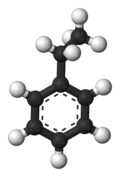This is an old revision of this page, as edited by JackieBot (talk | contribs) at 08:35, 16 February 2012 (r2.6.5) (Robot: Adding be:Этылбензол). The present address (URL) is a permanent link to this revision, which may differ significantly from the current revision.
Revision as of 08:35, 16 February 2012 by JackieBot (talk | contribs) (r2.6.5) (Robot: Adding be:Этылбензол)(diff) ← Previous revision | Latest revision (diff) | Newer revision → (diff)
| |||
| Names | |||
|---|---|---|---|
| IUPAC name Ethylbenzene | |||
| Other names
Ethylbenzol, EB, phenylethane | |||
| Identifiers | |||
| CAS Number | |||
| 3D model (JSmol) | |||
| ChEBI | |||
| ChEMBL | |||
| ChemSpider | |||
| DrugBank | |||
| ECHA InfoCard | 100.002.591 | ||
| KEGG | |||
| PubChem CID | |||
| RTECS number |
| ||
| UNII | |||
| CompTox Dashboard (EPA) | |||
InChI
| |||
SMILES
| |||
| Properties | |||
| Chemical formula | C8H10 | ||
| Molar mass | 106.168 g·mol | ||
| Appearance | Clear, colorless liquid | ||
| Density | 0.8665 g/mL | ||
| Melting point | −95 °C (−139 °F; 178 K) | ||
| Boiling point | 136 °C (277 °F; 409 K) | ||
| Solubility in water | 0.015 g/100 mL (20 °C) | ||
| Viscosity | 0.669 cP at 20 °C | ||
| Hazards | |||
| Occupational safety and health (OHS/OSH): | |||
| Main hazards | Flammable | ||
| NFPA 704 (fire diamond) |
 | ||
| Flash point | 15-20 °C | ||
| Related compounds | |||
| Except where otherwise noted, data are given for materials in their standard state (at 25 °C , 100 kPa).
| |||
Ethylbenzene is an organic compound with the formula C6H5CH2CH3. This aromatic hydrocarbon is important in the petrochemical industry as an intermediate in the production of styrene, which in turn is used for making polystyrene, a common plastic material.
Production
Although often present in small amounts in crude oil, ethylbenzene is produced in bulk quantities by combining benzene and ethylene in an acid-catalyzed chemical reaction:
- C
6H
6 + C
2H
4 → C
6H
5CH
2CH
3
Approximately 24,700,000 tons were produced in 1999. Catalytic dehydrogenation of the ethylbenzene then gives hydrogen and styrene:
- C
6H
5CH
2CH
3 → C6H5CH=CH2 + H
2
Other uses
Ethylbenzene has been used as a solvent for aluminium bromide in the anhydrous electrodeposition of aluminium. Ethylbenzene is also an ingredient in some paints, and solvent grade xylene (xylol) is nearly always contaminated with a few percent of ethylbenzene.
References
- Vincent A.Welch, Kevin J. Fallon, Heinz-Peter Gelbke “Ethylbenzene” Ullmann’s Encyclopedia of Industrial Chemistry, Wiley-VCH, Weinheim, 2005. doi:10.1002/14356007.a10_035.pub2
External links
- National Pollutant Inventory - Ethybenzene Fact Sheet
- NLM Hazardous Substances Databank – Ethylbenzene
- EPA Chemical database
- Intox Chemical database
- Agency for Toxic Substances and Disease Registry

